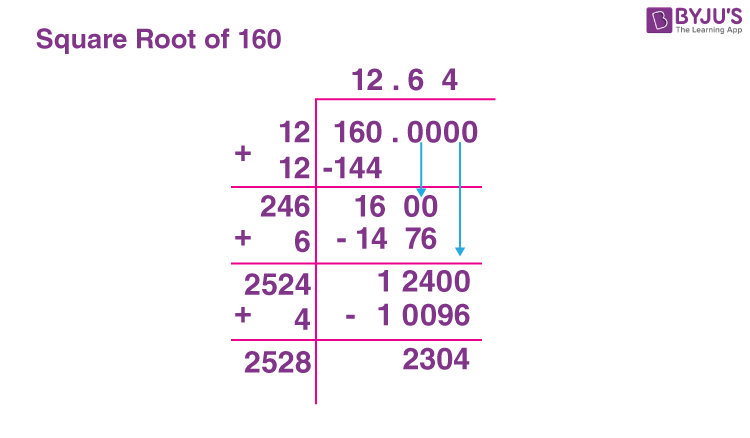There are many ways to calculate the square root of 160. Here, we will explore three approaches that provide a good approximation. Any number that can be expressed as the square of another integer is said to be a perfect square number. The square root of 160 is irrational since it is not a square number. The opposite of squaring is what is known as a number’s square root. The square root of 160 is expressed as √160 in radical form and as (160)½ in exponential form. We will explore how to calculate the square root of 160 in this article.
| Square Root of 160 |
|
| Square of 160 | 25600 |
What is the Square Root of 160?
The number whose square produces the value 160 is called the square root of 160. The number 160 is not a perfect square. As 160 is an irrational number, we calculate a rough approximation for its square root.
The quadratic equation x2 – 160 = 0 may also be used to represent the square root of 160.
⇒ x2 = 160
Now, take the square root on both sides, we get
⇒ x = √160
⇒ x = ± 12.649.
Also, try out: Square Root Calculator.
How to Calculate the Square Root of 160?
Let’s use the Newton formula, long division and prime factorization method to get the square root of 160. Since 160 is not a perfect square and its square root is an irrational number, the repeated subtraction approach will not work.
Finding Square Root of 160 Using Newton’s Equation
We employ Newton’s equation to get a number’s estimated square root for values that are not perfect squares. The Newton’s equation is written as,
√N ≈ ½ (N/A + A),
where
N is the integer whose square root we need to calculate.
A is the approximate square root estimate.
Here, N = 160 and A = 12, since 122 = 144 < 160. Let’s substitute these numbers in the formula to get a close approximation to find the square root of 160.
√160 ≈ ½ (160/12 + 12)
√160 ≈ ½ (13.33 + 12)
√160 ≈ 25.33/2
√160 ≈ 12.66.
This approach of calculating square roots is sometimes referred to as the approximation approach.
Finding Square Root of 160 by Prime Factorisation Method
By using the prime factorization technique, we can calculate the square root of 160 by first prime factorising the number. As 160 is a composite number, its prime factors are as follows:
The prime factorisation of 160 = 2 × 2 × 2 × 2 × 2 × 5 or 25 × 5
Square root of 160 = √[2 × 2 × 2 × 2 × 2 × 5] = 2 × 2 × √10
Square root of 160 = 4√10.
Finding Square Root of 160 by Long Division Method
By using the long division approach, we may get the square root of 160 by writing 160 as a dividend and pairing its digits from right to left. We must now determine the square root of 160:

Thus, √160 = 12.64 (approximately).
To determine the square root of any number using the long division technique, check out the following link:
Video Lessons on Square Root
Visualising square roots

Finding Square roots

Related Articles
- Square Root 1 to 100
- Squares and Square Roots
- Square Root of 10
- Square Root of 144
- Square Root of 120
- Square Root of 4
Solved Examples on Square Root of 160
Example 1:
What is the perimeter of a circle whose area is 160𝜋 m2.
Solution:
Assume that “r” be the radius of the circle.
We know that the area of the circle is 𝜋r2
I.e., 𝜋r2 = 160𝜋 m2
Now, cancel out 𝜋 on both sides of the equation, we get,
⇒ r2 = 160
Now, take the square root on both sides.
⇒ r = √160
⇒ r = + 12.64 m or – 12.64
Since, the length cannot be in negative value, we take r = 12.64.
Now, substitute r = 12.64 m in the perimeter of a circle formula,
The perimeter of the circle = 2𝜋r
P = 2 × 3.14 × 12.64
P = 79.38 m (approx.).
Thus, the perimeter of a circle is approximately equal to 79.38 m.
Example 2:
Determine the roots of the equation (a2 – 10a)/10 = (16.0 – a).
Solution:
Given equation: (a2 – 10a)/10 = (16.0 – a)
On simplifying the given equation, we get,
⇒ a2 – 10a = 160 – 10a
⇒ a2 – 160 = 0
⇒ a2 = 160
Taking square root on both sides, we get
⇒ a = √160 = ±12.64
Therefore, the roots of the given equation is:
a = 12.64 and a = -12.64.
Example 3:
What is the least number that has to be subtracted from 160 to make it a perfect square number? Furthermore, calculate the square root of the result.
Solution:
As we know, 122 = 144 < 160.
Hence, we should subtract 16 from 160.
Therefore, 160 – 16 = 144, which is a perfect square number.
Thus, the square root of 144, √144 is 12.
Frequently Asked Questions on Square Root of 160
What is the square root of 160?
The square root of 160 is approximately equal to 12.64.
Is the number 160 a perfect square?
No, 160 cannot be represented as the square of any integer, hence it is not a perfect square number.
Is the square root of 160 rational or irrational?
160 has a square root that is irrational.
How is 160 factorised into prime numbers?
Due to the fact that 160 is a composite number, its prime factorisation is 2 × 2 × 2 × 2 × 2 × 5 or 25 × 5.
What is the square root of 160 expressed in the simplest radical form?
The square root of 160 has the simplest radical representation as 4√10.